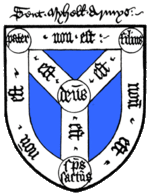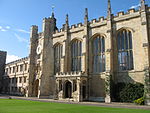Gonville and Caius College, often referred to simply as Caius ( KEEZ), is a constituent college of the University of Cambridge in Cambridge, England. Founded in 1348 by Edmund Gonville, it is the fourth-oldest of the University of Cambridge's 31 colleges and one of the wealthiest. In 1557, it was refounded by alumnus John Caius. The college has been attended by many students who have gone on to significant accomplishment, including fifteen Nobel Prize winners, the second-highest of any Oxbridge college after Trinity College, Cambridge.The college has long associations with the teaching of medicine, especially due to its prominent alumni in the medical profession. It also has globally-recognized and prestigious academic programmes in law, economics, English literature, and history. Famous Gonville and Caius alumni include physicians John Caius (who gave the college the caduceus in its insignia) and William Harvey. Other alumni in the sciences include Francis Crick (joint discoverer of the structure of DNA with James Watson), James Chadwick (discoverer of the neutron), and Howard Florey (developer of penicillin). Stephen Hawking, previously Cambridge's Lucasian Chair of Mathematics Emeritus, was a fellow of the college from 1965 until his death in 2018. Other notable alumni include John Venn (inventor of the Venn diagram), former Chancellor of the Exchequer and Father of the House of Commons Kenneth Clarke, comedian and Channel 4 television presenter Jimmy Carr, and former Downing Street director of communications Alastair Campbell.
Several streets in the city, including Harvey Road, Glisson Road, and Gresham Road, are named after Gonville and Caius alumni. The college and its masters have been influential in the development of the university, including in the founding of other colleges, including Trinity Hall and Darwin College and providing land on Sidgwick Site on which Faculty of Law was built.












